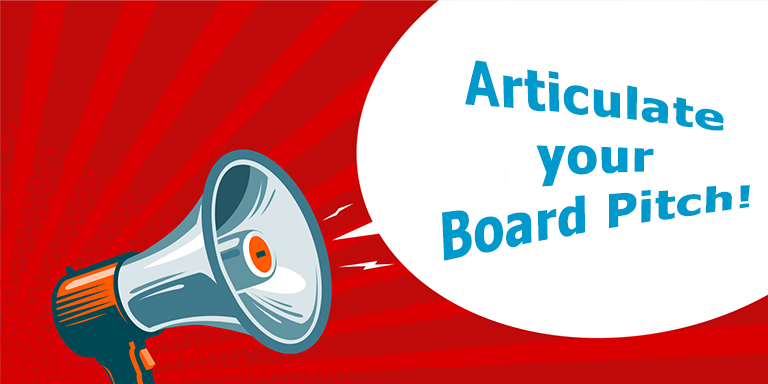All board applications require a supporting statement

When applying for an independent board seat, it is essential to include a supporting statement, even if it is not required. This will demonstrate your understanding of the role and help differentiate your application from others.
A board supporting statement is a document to include in a board application, along with a board cover letter and board resume. For clarity, it is recommended to keep the supporting statement separate from the board cover letter.
The purpose of a board application supporting statement?
A supporting statement addresses the applicant’s position with regard to each of the essential criteria sought by the recruiting organization. These criteria are usually listed in the board vacancy advertisement or position description. They reflect the qualifications and skills required to perform the role and also to address skill gaps within the current board. These essential criteria are also what recruiters, selection panels and chairs use to decide who to interview for the role.
Prior to writing a supporting statement, it is important to grasp what you need it to do. A well-crafted supporting statement should aim to accomplish the following objectives:
#1 Clearly states your accomplishments
A board resume lists your experience, and a board cover letter highlights your achievements and differentiates you from other candidates. However, a supporting statement should provide evidence of your skills, experience, and success as a potential board member.
#2 Provide a document to easily grade your board application
Recruiters and selection panels assess board applications to determine interview invitations by evaluating each application against essential selection criteria. Including robust supporting statements streamlines the grading process, enhancing your ability to communicate effectively. Providing precise details in your statement aids the grading team in comprehending your qualifications thoroughly, minimizing the risk of assumptions or overlooking crucial information.
# 3 Differentiating yourself from your competition is important
It is common to receive hundreds of board applications for a single board vacancy. To increase your chances of getting your application noticed, it is crucial to include a strong supporting statement. A detailed supporting statement can significantly impact the application grading process in your favor. One reason is that only some candidates put in this level of effort.
In my 15+ years of experience in board recruitment, I have noticed that most candidates only include a supporting statement with their board application if asked. Those who do often approach it with insufficient preparation and not conducting enough research. Some may merely refer to their board resume or LinkedIn profile. A strong, well-structured supporting statement can help your board application stand out and increase your chances of being noticed.
#4 – It Demonstrates commitment
Writing a supporting statement requires effort and research. It is not a simple task of cutting, pasting, and editing like a cover letter. The document is tailored to fit a specific board role and must be written from scratch. Chairs and recruiters recognize the commitment to creating a compelling board supporting statement. This commitment shows demonstrable passion, one of the core criteria for being a perfect board candidate.
#5 Helps prepare for the board interview
Conducting thorough research and writing a detailed supporting statement that evidences your board or strategic success will prepare you well for a successful board interview.
#6 Assess whether the role aligns with your skills and interests
The process of matching your skills and experience with the selection criteria can help you determine if the role is a good fit for you. It is not uncommon for individuals to realize that a role they were initially excited about may not align with their abilities or board aspirations.
Tips for writing a compelling supporting statement
The structure of a board supporting statement follows a formulaic approach. This may feel limiting to some as it lacks the opportunity to include additional context or personal touches. I recommend you incorporate these aspects into your board cover letter. The focus of the supporting statement should be on providing essential information for the advertiser or recruiter to decide on inviting you for an interview.
Consider the following tips to create a solid supporting statement for a board application.
TIP 1 – Preparation
It is important to conduct thorough online board research before writing anything. Review the selection criteria for the independent director role and note 3 to 6 examples that demonstrate achievements relevant to the criteria. It is important to note that the board and organization seek a candidate who poses no risk and can fulfil the role’s responsibilities.
TIP 2 – Address all the essential criteria
A board supporting statement is a document that outlines how the applicant’s skills and experiences align with the specific requirements of the role. The assessing committee is then able to compare all candidates using the same set of criteria. It is important to address all criteria when submitting your application, not just the desirable ones or those that best support you. The first step involves copying and pasting all the selection criteria from the advert or job specification into a Word document. This is the foundational structure for your supporting statement.
Convert each criterion to a heading, then write 1-2 short paragraphs (though I am just as happy if you prefer to use bullet points – actually, they can be more effective) about how you meet each criterion. It is important to recognize that simply presenting facts may not suffice in this context. You must include examples highlighting successful outcomes and how you achieved them. You should also consider the accomplishments you achieved as a group while serving on boards or committees.
TIP 3 – Don’t skip any criteria
Be sure to address all selection criteria, regardless of any perceived skills, knowledge, or experience gaps. While it may be tempting to avoid mentioning them, they will likely be noticed. Consider all aspects of your experience, including board-level positions, strategic roles, committee involvements, group management experience, and volunteer work. Suggest your willingness to acquire any required skills or knowledge.
TIP 4 – Never combine essential criteria
You should refrain from combining criteria that you consider similar. I can assure you that the organization has carefully formulated the essential criteria and that each criterion is different. If there is any confusion, it would be best to have a conversation with the advertiser to clarify any distinctions. I can guarantee that there is one, and you will be judged if you don’t address it.
TIP 5- Use a simple format and style
Your supporting document must be presented in a style and format that makes it easy to read, easy for the information to comprehend and to reach the right conclusions. Formatting tips include:
- Keep the document to 2-3 paragraphs in length. Of course, this will vary based on the number of essential and desirable selection criteria listed in the advertisement or role description.
- Keep your paragraphs in the same order as the selection criteria.
- Keep your paragraphs short and to the point, and avoid large blocks of text.
- Use bullet points where appropriate.
- Use a simple font that is easy to read.
- Use the same language and terminology as the advertisement or job description.
- Use action-orientated words, e.g. executed, incorporated, led, secured, negotiated, maximized.
- If there is a word or character limit, don’t go over it.
TIP 6 – Consider the using the T. E. E. method
Supporting statements frequently focus excessively on explaining the background of an applicant’s experience. There is often an overemphasis on the task involved in one’s work rather than the actual outcomes and successes. But, it is the latter that will differentiate you from your competitors.
When addressing the selection criteria for a board director role, consider including the three elements of the TEE method of paragraph writing. These elements are:
Technical: Clearly state that you meet the requirements. Reframe the criteria from a question to a statement. For example, if the criteria concerns governance, state clearly that you have X years of governance experience. Make the statement powerfully and unambiguously, then;
Example: Provide examples that support the previous statement. Something like ‘Perhaps the best example I can provide demonstrating my governance experience is as an Independent Director of Company X for Y years’ then finally,
Evidence: Provide examples of success in these roles. Perhaps say something like: ‘Whilst serving as an Independent Director of Company X, I improved governance by…’ (include your success and outcomes).
Writing a board application can be challenging
Writing board applications, including board supporting statements, is not a popular task among many aspiring directors. The lengthy and laborious process may affect the quality and effort put into submitted applications. A solid supporting statement can help you stand out from competitors and make a compelling case for your appointment. That is why I recommended always submitting a supporting statement with every board application.
If you are unsure whether your supporting statement is compelling? We can help. Our Board Appointment Coaching PLUS Membership package offers unlimited application reviews.
Related Articles
A guide to writing a Board Cover Letter
What are the common types of boards and board roles?
About the Author
David Schwarz is CEO & Founder of Board Appointments. He has over a decade of experience in putting people on boards as an international headhunter and recruiter. He has interviewed hundreds of directors and placed hundreds into some of the most significant public, private and NFP director roles in the world.







I have a question: is the board statement a separate doc, meaning that an applicant submits 3 docs as her/his application: a CV, a cover ltr and a board statement. Or it the content of the board statement incorporated into the cover ltr?
Also it seems to me that content in the board statement is the purpose of a cover ltr; to demonstrate the applicant’s qualifications for the Board position. Big thx in advance for your reply. Tom Nastas